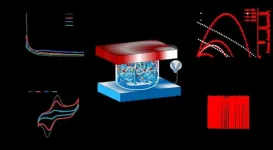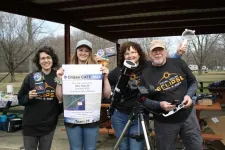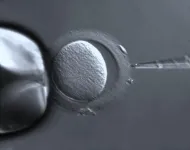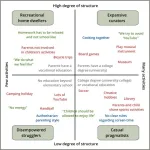The team, led by Robert Ritchie at Lawrence Berkeley National Laboratory (Berkeley Lab) and UC Berkeley, in collaboration with the groups led by professors Diran Apelian at UC Irvine and Enrique Lavernia at Texas A&M University, discovered the alloy’s surprising properties and then figured out how they arise from interactions in the atomic structure. Their work is described in a study that was published April 11, 2024 in Science.
“The efficiency of converting heat to electricity or thrust is determined by the temperature at which fuel is burned – the hotter, the better. However, the operating temperature is limited by the structural materials which must withstand it,” said first author David Cook, a Ph.D. student in Ritchie’s lab. “We have exhausted the ability to further optimize the materials we currently use at high temperatures, and there’s a big need for novel metallic materials. That’s what this alloy shows promise in.”
The alloy in this study is from a new class of metals known as refractory high or medium entropy alloys (RHEAs/RMEAs). Most of the metals we see in commercial or industrial applications are alloys made of one main metal mixed with small quantities of other elements, but RHEAs and RMEAs are made by mixing near-equal quantities of metallic elements with very high melting temperatures, which gives them unique properties that scientists are still unraveling. Ritchie’s group has been investigating these alloys for several years because of their potential for high-temperature applications.
“Our team has done previous work on RHEAs and RMEAs and we have found that these materials are very strong, but generally possess extremely low fracture toughness, which is why we were shocked when this alloy displayed exceptionally high toughness,” said co-corresponding author Punit Kumar, a postdoctoral researcher in the group.
According to Cook, most RMEAs have a fracture toughness less than 10 MPa√m, which makes them some of the most brittle metals on record. The best cryogenic steels, specially engineered to resist fracture, are about 20 times tougher than these materials. Yet the niobium, tantalum, titanium, and hafnium (Nb45Ta25Ti15Hf15) RMEA alloy was able to beat even the cryogenic steel, clocking in at over 25 times tougher than typical RMEAs at room temperature.
But engines don’t operate at room temperature. The scientists evaluated strength and toughness at five temperatures total: -196°C (the temperature of liquid nitrogen), 25°C (room temperature), 800°C, 950°C, and 1200°C. The last temperature is about 1/5 the surface temperature of the sun.
The team found that the alloy had the highest strength in the cold and became slightly weaker as the temperature rose, but still boasted impressive figures throughout the wide range. The fracture toughness, which is calculated from how much force it takes to propagate an existing crack in a material, was high at all temperatures.
Unraveling the atomic arrangements
Almost all metallic alloys are crystalline, meaning that the atoms inside the material are arranged in repeating units. However, no crystal is perfect, they all contain defects. The most prominent defect that moves is called the dislocation, which is an unfinished plane of atoms in the crystal. When force is applied to a metal it causes many dislocations to move to accommodate the shape change. For example, when you bend a paper clip which is made of aluminum, the movement of dislocations inside the paper clip accommodates the shape change. However, the movement of dislocations becomes more difficult at lower temperatures and as a result many materials become brittle at low temperatures because dislocations cannot move. This is why the steel hull of the Titanic fractured when it hit an iceberg. Elements with high melting temperatures and their alloys take this to the extreme, with many remaining brittle up to even 800°C. However, this RMEA bucks the trend, withstanding snapping even at temperatures as low as liquid nitrogen (-196°C).
To understand what was happening inside the remarkable metal, co-investigator Andrew Minor and his team analyzed the stressed samples, alongside unbent and uncracked control samples, using four-dimensional scanning transmission electron microscopy (4D-STEM) and scanning transmission electron microscopy (STEM) at the National Center for Electron Microscopy, part of Berkeley Lab’s Molecular Foundry.
The electron microscopy data revealed that the alloy’s unusual toughness comes from an unexpected side effect of a rare defect called a kink band. Kink bands form in a crystal when an applied force causes strips of the crystal to collapse on themselves and abruptly bend. The direction in which the crystal bends in these strips increases the force that dislocations feel, causing them to move more easily. On the bulk level, this phenomenon causes the material to soften (meaning that less force has to be applied to the material as it is deformed). The team knew from past research that kink bands formed easily in RMEAs, but assumed that the softening effect would make the material less tough by making it easier for a crack to spread through the lattice. But in reality, this is not the case.
“We show, for the first time, that in the presence of a sharp crack between atoms, kink bands actually resist the propagation of a crack by distributing damage away from it, preventing fracture and leading to extraordinarily high fracture toughness,” said Cook.
The Nb45Ta25Ti15Hf15 alloy will need to undergo a lot more fundamental research and engineering testing before anything like a jet plane turbine or SpaceX rocket nozzle is made from it, said Ritchie, because mechanical engineers rightfully require a deep understanding of how their materials perform before they use them in the real world. However, this study indicates that the metal has potential to build the engines of the future.
This research was conducted by David H. Cook, Punit Kumar, Madelyn I. Payne, Calvin H. Belcher, Pedro Borges, Wenqing Wang, Flynn Walsh, Zehao Li, Arun Devaraj, Mingwei Zhang, Mark Asta, Andrew M. Minor, Enrique J. Lavernia, Diran Apelian, and Robert O. Ritchie, scientists at Berkeley Lab, UC Berkeley, Pacific Northwest National Laboratory, and UC Irvine, with funding from the Department of Energy (DOE) Office of Science. Experimental and computational analysis was conducted at the Molecular Foundry and the National Energy Research Scientific Computing Center – both are DOE Office of Science user facilities.
###
Lawrence Berkeley National Laboratory (Berkeley Lab) is committed to delivering solutions for humankind through research in clean energy, a healthy planet, and discovery science. Founded in 1931 on the belief that the biggest problems are best addressed by teams, Berkeley Lab and its scientists have been recognized with 16 Nobel Prizes. Researchers from around the world rely on the Lab’s world-class scientific facilities for their own pioneering research. Berkeley Lab is a multiprogram national laboratory managed by the University of California for the U.S. Department of Energy’s Office of Science.
DOE’s Office of Science is the single largest supporter of basic research in the physical sciences in the United States, and is working to address some of the most pressing challenges of our time. For more information, please visit energy.gov/science.
END








